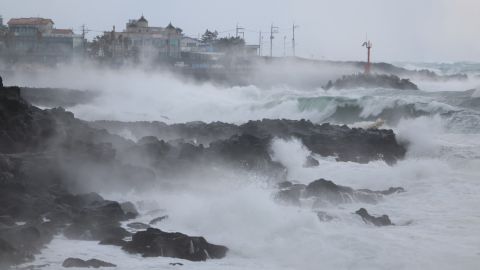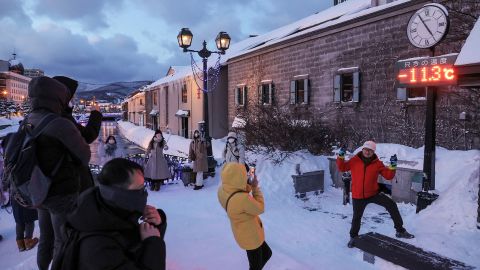hong kong
CNN
—
Tens of millions of people across East Asia braved a severe cold spell on Wednesday as sub-zero temperatures and heavy snowfall caused travel chaos during the Lunar New Year holiday, with climate experts warning that such extreme weather events had become the “new normal”.
South Korea issued heavy snowfall warnings this week as temperatures in the capital Seoul fell as low as minus 15 degrees Celsius (minus 5 degrees Fahrenheit) and dropped to record lows in other cities, officials said.
On the popular tourist island of Jeju, bad weather led to the cancellation of hundreds of flights while passenger ships were forced to stay in port due to huge waves, according to the central disaster and disaster headquarters. -security measures.
“The cold air from the North Pole directly reached South Korea,” after passing through Russia and China, Korea Meteorological Administration spokesman Woo Jin-kyu told CNN.
See what life is like in one of the coldest places on earth
Woo said that if scientists take a long-term view of climate change, “we can consider this extreme weather – extremely hot weather in summer and extremely cold weather in winter – as one of the signals of climate change.”
Across the border in Pyongyang, North Korean authorities warned of extreme weather conditions as the cold spell swept across the Korean peninsula. Temperatures in parts of North Korea are expected to drop below minus 30 degrees Celsius (minus 22 degrees Fahrenheit), state media reported.
In neighboring Japan, hundreds of domestic flights were canceled on Tuesday and Wednesday due to heavy snowfall and high winds that hampered visibility. Major carriers Japan Airlines and All Nippon Airways canceled a combined total of 229 flights.

Meanwhile, bullet trains have been suspended between Fukushima North and Shinjo stations, Japan Railway Group said.
China’s meteorological authority also predicted sharp drops in temperature for parts of the country and issued a blue alert for a cold spell on Monday – the lowest level in a four-tier warning system.
Mohe, China’s northernmost city, saw temperatures dip to minus 53 degrees Celsius (minus 63.4 degrees Fahrenheit) on Sunday – its coldest on record, meteorologists said. Ice fog – a weather phenomenon that only occurs in extremely cold weather when water droplets in the air remain in liquid form – is also expected in the city this week, local authorities said.

Yeh Sang-wook, a climate professor at Hanyang University in Seoul, attributed the extreme cold snap on the Korean peninsula to arctic winds from Siberia, adding that the cold snap in South Korea this year was partly due to melting arctic ice caps from a warming climate.
“There was a meltdown record last year and this year,” he said. “As the sea ice melts, the sea opens up, sending more steam into the air, bringing more snow to the north.”
As climate change worsens, the region will face more severe cold temperatures in the future, he said.
“There is no other (explanation),” he said. “Climate change is indeed getting worse and there is a consensus among world scientists that this type of cold weather is going to get worse in the future.”
Kevin Trenbergh of the US National Center for Atmospheric Research (NCAR) agreed that “extreme weather events are the new normal”, adding: “We can certainly expect extreme weather to be worse than they weren’t before.”
He also highlighted the El Niño and La Niña climate cycles in the Pacific Ocean that affect weather patterns around the world.
La Niña, which generally has a cooling effect on global temperatures, is one of the reasons for the current cold snap, he said.
“There is certainly a lot of natural variability that occurs over time but…we often hear about the El Nino phenomenon and right now we are in the La Niña phase. And that certainly influences the types of patterns that tend to occur. And so he’s also a player,” he said.
